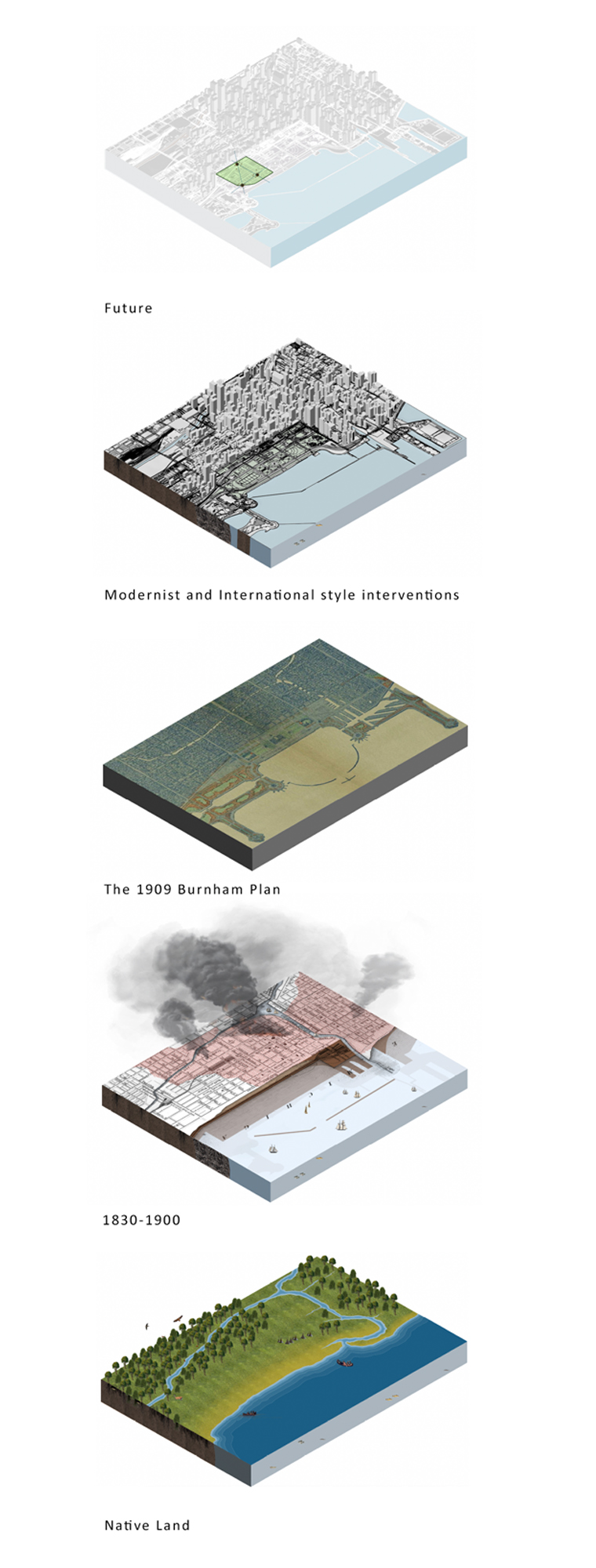LANDSCAPES OF REFLECTION, FOREGIVENESS and HOPE
– Re-imagining Grant Park in Chicago
The city of Chicago, ranked as one of the so-called beta cities in our globalized world and the land once called Chicagou, is an urban conglomeration that emerged from layer upon layer of cultural inscriptions over a complex ecosystem in the Great Lakes Region of North America. Chicago represents a near perfect example of industrialized capitalist city-building processes since the early colonization of the Americas and the changing layers of ontological shifts in the Western relationship to nature, to trade and to material flows are visible in the appropriation of landscapes, in past planning protocols, in infrastructure and architecture, and in the organization of everyday life.
Recent socio-political and environmental concerns among Chicagoans reflect similar questions world-wide and prompted an exploration of a rather innocent looking landscape which nevertheless functions as connective tissue between historically important cultural institutions along the Lake Front. In this case also the very same institutions that are reconsidering their own role and relevance in the complicated history of the city and the landscape that stretches from The Museum of the Art Institute north to the Field Museum south – both existing on the landfill that appropriated the wet landscape between Michigan Avenue and the current edge of Lake Michigan after the Chicago fire of 1871.
Four distinct layers of cultural inscription are considered: First, the land called home by the first nations that lived with the land; second, the appropriation and molding of the land in a Beaux Art style and famously referred to as the 1909 Chicago Plan by Burnham; third, the layer of modernist and international style interventions in the years between the 1933 Century of Progress and 1964 New York City world fairs – including the subsequent infrastructural changes mostly linked to transportation; and fourth, the reclaiming of public open space through lake-front redevelopment over the past three decades.
By looking at these four layers it prompted the question of what can or should be next in this process of continued inscribing and molding of the lake front landscape. The value of open public space and the assumption of free and open access for all are certainly important. But the question about how to make historical layers visible while also allowing collaborative co-creation of a site that will bring people together to reflect, to forgive and to claim ownership of a shared future condition seem to challenge the limitations of current landscape design practices. Exploring this question may be categorized as landscape architecture – but the hope and intention remain that the scenarios can collapse disciplinary boundaries and project a future layer as a landscape of forgiveness and hope.
The thesis proposes a future urban landscape as a layer of forgiveness, reflection and hope inscribed into a series of already active public spaces which are curated and controlled through city planning policies, maintenance procedures and use ordinances. This future layer will improve connections, create opportunities for collaborative projects and be allowed to mature through a series of contingent landscape interventions that will over time become a neutral ground plane upon which future scenarios can play-out. As such, the thesis proposes a series of initial first steps that can act as anchors for the re-appropriation of the landscape and which are illustrated through a number of possible longer-term scenarios.
The thesis does not aim to present a singular solution in time – but rather speculate on any number of possible future landscapes that can grow, link and attach to the contingent spatially inserted anchor points in the current landscape. These anchor points reflect the triangulated spatial relationship that exists between three conceptual development strategies. First, the concept of memory activated through a process of [un-]folding; second the concept of erasure activated through a process of restoration and third, the concept of belonging activated through lines of movement.
